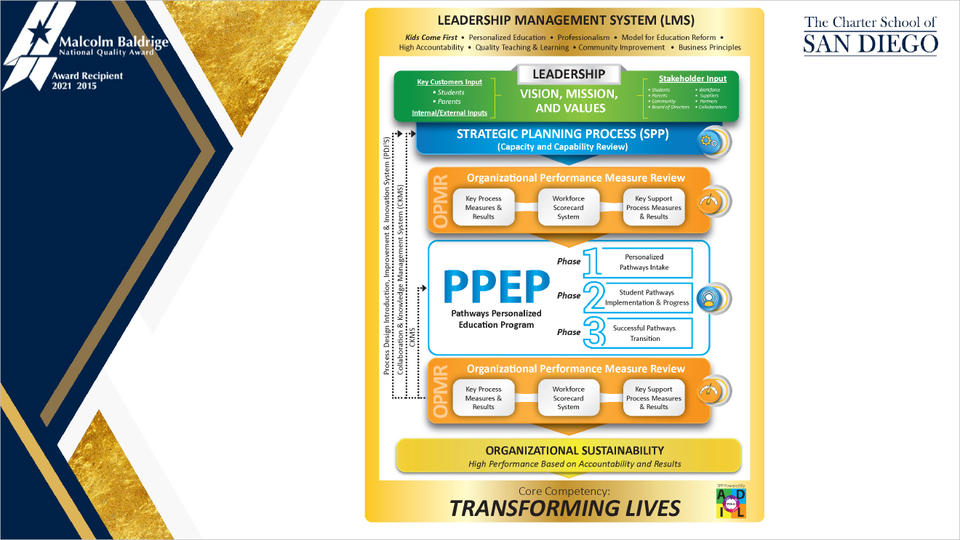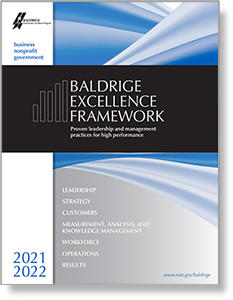Blogrige
The Official Baldrige Blog

CSSD's Leadership Management System slide from its Quest for Excellence senior leadership plenary presentation.
Three-Part Leadership Blog Series
In this three-part blog series on the 2021 Baldrige Award recipients’ leadership presentations at the 33rd Quest for Excellence® Conference (April 3–6, 2022), senior leaders of the three new national role models share best practices and stories of how they achieved excellence.
Innovation through Cross-Sector Learning

2021 Baldrige Award recipient The Charter School of San Diego (CSSD) returned last week to the Baldrige Program’s annual best-practice-sharing conference (the Quest for Excellence®) to present more than mere improvements in its performance since it received its first Baldrige Award in 2015.
Starting with CSSD Executive Director Tim Tuter’s leadership presentation, it was clear that organizational learning and innovation continue to play a key role in sustaining the high performance of the nearly 30-year-old public charter school.
Like other organizations that use the Baldrige Excellence Framework as a foundation for continuous improvement and innovation of their work processes and results, CSSD does not hesitate to look outside its sector for best practices to emulate. The school adopts and customizes promising ideas from both similar and very different institutions and also uses cross-sector data for benchmarking. For example, when CSSD began searching for comparison data to help it reach the highest-possible performance levels for a few of its student-focused measures, it chose to benchmark two U.S. service businesses with industry-leading reputations for customer service.
A new example of such cross-sector sharing and learning, described by CSSD last week at the Baldrige conference: its launch of a school-based Fellows program. It was inspired by the Baldrige Executive Fellows Program for aspiring or established C-level executives of U.S. organizations. At CSSD, the program provides leadership development for select staff members while also fostering innovation. In just a few years, CSSD Fellows’ innovative capstone projects have enriched the school and helped it address both known and unexpected challenges.
One such innovation has had a crucial impact for CSSD student learning during the COVID-19 pandemic—resulting in “no learning loss” during facilities’ temporary shut-downs, according to school data. That is, through a CSSD Fellow’s 2019 project, the school secured WiFi hot spots in the homes of its students. The original impetus for the project was the finding that a lack of regular WiFi service caused challenges for students’ use of school laptops for homework. But the solution to this problem later enabled CSSD to maintain virtual lessons uninterrupted by pandemic-related closings. Meanwhile, many other schools in the area struggled to offer ongoing instruction for their students. As a result, CSSD experienced enrollment gains as parents searched for an option to keep their teens engaged in academic coursework.
CSSD’s History and Operational Structure
Since it became the San Diego Unified School District’s first charter school in 1993—and one of the first charter schools in the nation—CSSD has had its charter renewed by the public school district five times and maintains full accreditation, Tuter shared.
He said that, while the charter school is “free” from some bureaucratic constraints of other public schools in its district, this flexibility is granted “in exchange for higher levels of accountability and sharing.”
With a total annual enrollment of approximately 3,500 students, CSSD serves an extremely diverse school community of mostly at-risk students—75% of whom arrive deficient in high school credits. CSSD operates on a 12-month calendar, and summer is one of its busiest seasons, said Tuter, due to seasonal enrollment from additional students who need to catch up on high school credits.
CSSD school facilities are organized as “neighborhood resource centers,” which Tuter described as “multiple safe, storefront campuses” that offer hybrid in-person/independent study programs. Although the storefront campuses are leased to enable CSSD to move sites to accommodate student population declines or growth, the school also owns five properties.
CSSD’s instructional lead, Jay Garrity, noted that the personalized education plans offered by the school, using a university model, support students’ self-sufficiency. He also mentioned that CSSD’s resource centers are designed to enable students to thrive in their use of advanced technology, for example, through equipment such as 3-D printers.
Key Processes and Keys to Success
CSSD’s Leadership Management System (LMS; depicted in the graphic above) has been refined a lot, said Tuter. He described this system as “the way that CSSD successfully transforms lives.” (The school defines its core competency as Transforming Lives.) The LMS encompasses CSSD’s key processes: the three-phase Pathways Personalized Education Program, the 11-step Strategic Planning Process, and the Organizational Management System. Tuter called CSSD a model for education reform, stressing its accountability and results.
The Leadership Management System is “the way that CSSD successfully transforms lives,” said Tuter.
“CSSD has an entire data department that tracks progress daily,” Tuter noted, explaining that within 90 days of each student’s enrollment, CSSD “must get each student on track.” CSSD’s student-focused performance measures include student confidence, graduation rate (for which CSSD compares its results to local public schools’ and colleges’ rates), student transition rate, and student satisfaction.
As CSSD approaches the 30-year anniversary of its first charter approval, Tuter identified the following as “keys to sustaining our success”:
- having a key process focused on customers
- consistently using data to inform the work of all departments
- maintaining high employee engagement and retention (e.g., by offering salaries that are 5% higher than the local district’s)
- aligning strategic planning to employee input and performance scorecards
- building leadership at all levels (through career progression opportunities)
- monitoring fiscal measures (The school’s financial planning allows it to operate for at least one year without new funding.)
Last on Tuter’s list of CSSD’s keys to success—though clearly of great importance for personal and organizational learning—was workforce education and development. CSSD “includes two schools,” Tuter explained. “One for the workforce, and one for students.”
Three-Part Leadership Blog Series: Upcoming Blogs
Leadership Practices of 2021 Baldrige Award Recipient Mid-America Transplant (Nonprofit)
Absolute Focus on Customers, Values, and Baldrige Inspires MidwayUSA to Gains (Service)

Baldrige Excellence Framework®
The Baldrige Excellence Framework has empowered organizations to accomplish their missions, improve results, and become more competitive. It includes the Criteria for Performance Excellence, core values and concepts, and guidelines for evaluating your processes and results.
Purchase your copy today!
Available versions: Business/Nonprofit, Education, and Health Care





